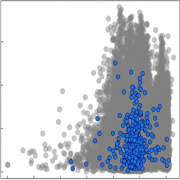PLoS Biology: The magic of heterosis explained
Nonlinear phenotypic variation uncovers the emergence of heterosis in Arabidopsis thaliana
François Vasseur , Louise Fouqueau, Dominique de Vienne, Thibault Nidelet, Cyrille Violle, Detlef Weigel
PLoS Biology https://doi.org/10.1371/journal.pbio.3000214
Heterosis describes the phenotypic superiority of hybrids over their parents in traits related to agronomic performance and fitness. Understanding and predicting nonadditive inheritance such as heterosis is crucial for evolutionary biology as well as for plant and animal breeding. However, the physiological bases of heterosis remain debated. Moreover, empirical data in various species have shown that diverse genetic and molecular mechanisms are likely to explain heterosis, making it difficult to predict its emergence and amplitude from parental genotypes alone. In this study, we examined a model of physiological dominance initially proposed by Sewall Wright to explain the nonadditive inheritance of traits like metabolic fluxes at the cellular level. We evaluated Wright’s model for two fitness-related traits at the whole-plant level, growth rate and fruit number, using 450 hybrids derived from crosses among natural accessions of A. thaliana. We found that allometric relationships between traits constrain phenotypic variation in a nonlinear and similar manner in hybrids and accessions. These allometric relationships behave predictably, explaining up to 75% of heterosis amplitude, while genetic distance among parents at best explains 7%. Thus, our findings are consistent with Wright’s model of physiological dominance and suggest that the emergence of heterosis on plant performance is an intrinsic property of nonlinear relationships between traits. Furthermore, our study highlights the potential of a geometric approach of phenotypic relationships for predicting heterosis of major components of crop productivity and yield.
Heterosis primer by Diddahally R. Govindaraju




